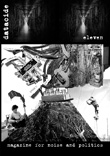Cyrus Bozorgmehr,
The Rabbit Hole
(Creative Space, 2013)
and other writings at djbroadcast.net

Writing about music counter-cultural tendencies that we participate in poses questions about historification that are not easily resolved, but are rather left in a state of perpetual negotiation. Those who choose to undertake the task of critical writing that present counter-narratives to the omnipresence of music industry journalism in print magazines and on a plethora of music websites inevitably make strategic choices about modes of counter-dialogue to engage diverse readerships. In the last few years, there has been a resurgence of artists/musicians/participants who have printed a number of provocative books that we have followed with great interest. The medium of photography and the photo book was used to tell multiple, interconnected stories about free parties in the Paris catacombs in the truly illuminating Paname sans dessus, dessous! published in 2006. In datacide 10, I reviewed the problematics of Pencilbreak: A Graphicore Compilation, which took the strategy of representing music through the visual medium of flyers, posters and album covers. Published in 2011, Sudden Infant: Noise in My Head, The Actionistic Music and Art of Joke Lanz is a fascinating book that operates on multiple levels as a memoir, a photo book, a collaborative self-history and a discography through the inclusion of an interview with Joke Lanz, drawings, photos of performances, manifestos, poetry, concert posters and flyers, texts by collaborators, and a visual discography. Riccardo Balli engaged in a plundering of counter-narrative strategies in his Italian language publication on Milan’s Agenzia X called Apocalypso Disco: La Rave-o-luzione della Post Techno. The excellent book includes interviews with artists such as Christoph Fringeli, Sansculotte, Daniel Erlacher (Widerstand Records), Ralph Brown and others. Several chapters are made up of Balli’s ingeniously amusing counter-histories of interconnected music genres in a fictional plundering of writings of Philip K. Dick and Fulcanelli (first published in English in Datacide). Another book chapter blurs the boundaries completely between fiction and non-fiction in a retelling of some aspects of the Dead By Dawn parties in 1995. Academic writing informed by ethnographic and anthropological methodologies about sub-cultural musical experiences are investigated in the interview with Graham St. John in another book chapter. Most recently this year, there are two engaging examples of mixing the curatorial project of presenting counter-cultural tendencies through exhibitions with that of a companion book. One project was the exhibit and book Berlin Wonderland: The Wild Years Revisited 1990-1996, which featured short personal narrative texts by artists in music, theater and the arts that gave context to photographs grouped together in themes like ‘open doors’, ‘disarmament experts’, ‘wild gangs’ (both which focus on Mutoid Waste Company), etc. Opening on October 1 in Newcastle, Australia is Fistography – Bloody Fist Records – The Exhibition that displays all the label’s releases in chronological order along with ephemera including press clippings, posters, flyers, equipment and photos. This is a truly monumental archival undertaking documenting the years 1993-2004. Simultaneously, an internet radio broadcast out of Hertford featured the BF back catalog. The exhibit is complemented by a show featuring Xylocaine, Hedonist, Epsilon and Mark N spinning BF tunes on Oct 3. Mark N has also published a 300-page book documenting the label’s history titled Fistography: Bloody First Records, Newcastle, Australia, 1994-2004. Critical readers and participants may have these and many other examples in mind when undertaking the ruckus, fictional experience that is The Rabbit Hole.
This is a deeply amusing fictional novel that will no doubt make readers laugh wildly and at the next turn snicker knowingly at the maschinations of a collective that in one summer throws massive renegade soundsystem parties in various locations in and around London. Many readers, including myself, track down this paperback or ebook because it is one of the few fictional narratives about the worldwide teknival movement, and it is written by Cyrus Bozorgmehr aka Sirius, member of Spiral Tribe and SP23. One of the pleasures of reading this book is the constant elision between fiction, personal experience, and (non)-history – the reader may ask herself at any particular moment, ‘Is this a history of a soundsystem crew revealed in a over-the-top, far-fetched retelling, or a narrative slight of hand imagining what could be?’. That inquiry only takes the reader so far since there’s a lot going on in the book. What becomes much more satisfying is the reader’s traversal of the literary play between the comical, the serious, and the caricatured as the crew members’ grapple with the principles that inform their collective actions, deploy strategies of collaborative artistic creation, experiment with the transformative potential of music, deal with the insidious nature of the music industry and commercialism, and negotiate state repression and infiltration. [Read more →]
Mark Harrison tells Neil Transpontine about the origins of Spiral Tribe, their crucial role in formenting early 1990s free parties and teknivals, and what they did next… and are still doing

1. Spiral Tribe, and similar sound systems brought a different energy into the post-acid house scene, it felt like their roots were less in warehouse soul and funk (like many in that scene) and more in alternative sub/counter-cultures. Echoes of 1980s free festivals, anarcho-punk squatting, maybe even Psychic TV (importance of symbols etc). In that context, can you tell us a little about how Spiral Tribe came about? What kinds of things had people been involved in before it came together?
There were as many threads that wove together to form Spiral Tribe as there were different individuals involved. There are just too many people to list here in this short article.* Many people drifted in and out, others stayed, but without them all, working together as a collective, none of it would have been possible. Having said that, in the very beginning there were just four of us who were dedicated full time to making it happen.
Debbie Griffith, aged twenty-nine at the time, was a painter and decorator and occasional nanny, who lived just off Kilburn High Road. Simone Trevelyan, who was nineteen, worked in a disco equipment hire shop in Kentish Town. My brother, Zander Harrison, twenty-seven, a tree surgeon, worked all over West London. And then myself, Mark Harrison. I too was twenty-nine and had just moved down to London from Manchester where I’d lived for five years. Much of that time (if not all of it) I’d spent in the Hacienda and so I was at ground zero that Wednesday night when Acid House and ecstasy were unleashed. The world was never the same again. [Read more →]
Shut Up and Dance’s 1991 hardcore LP ‘Dance Before the Police Come’ was released at a time when the UK authorities were struggling to contain the massive explosion of raves. Thousands of people each weekend were playing a cat and mouse game with the police to party in fields and warehouses, and if the state was often outwitted by meeting points in motorway service stations and convoys of cars, it tried to keep the lid on the phenomenon by staging high profile raids. In 1990, for instance, an incredible 836 people were arrested at a Love Decade party in Gildersome near Leeds in the north of England.
Since then the global spread of Electronic Dance Music has generally been accompanied by the flashing blue light, the siren, and that moment when the music is abruptly turned off and the order given to clear the building. Indeed, let’s face it, the frisson of illegality has sometimes added a pleasurable edge to partying – the thrill of overcoming official obstacles just to get there, of getting one over on the authorities. And even the most mainstream of commercial club promoters like to pose as underground outlaws because they once got told to turn the music down by a man in uniform.
But police raids are serious business – often involving arrests which can lead to imprisonment, people losing their livelihoods and, in some parts of the world, social ostracism. People get injured, beaten and sometimes even killed. This article looks at a sample of police raids in recent times to get a sense of the current state of play between cops and dancers in different parts of the world. [Read more →]
Parties continue and there are probably more producers than ever thanks to computers and free, easy-to-source software.
Overall I’d say the ‘scene’ in this country has deteriorated as the previously strong links between music and a wider culture of resistance have dissipated.
The numbers involved in ‘free’ parties have diminished and much of the initial energy and enthusiasm for autonomy and freedom has been absorbed by the mainstream and turned into hopeless consumption.
Due to ongoing gentrification and other factors squatting in ‘our culture’ has become less and turned in on itself rather than always seeking contact with an outside.
At the same time it’s important to maintain some perspective and acknowledge that the moment of free parties as a ‘mass’ popular movement has perhaps come and gone, and to concentrate on pushing ideas and expression wherever possible. [Read more →]

Datacide Eleven
release date: February 2011. 64 pages.
Datacide events, page 3
Nemeton: Political news, page 4
Features
Christoph Fringeli: Hedonism and Revolution: The Barricade and the Dancefloor, page 6
Stewart Home: Dope smuggling, LSD manufacture, organized crime & the law in 1960s London, page 8
John Eden: Shaking the Foundations: Reggae soundsystem meets ‘Big Ben British values’ downtown, page 12
Alexis Wolton: Tortugan tower blocks? Pirate signals from the margins, page 16
Neil Transpontine: Dance before the police come, page 21
Christoph Fringeli: From Subculture to Hegemony: Transversal Strategies of the New Right in Neofolk and Industrial, page 24
Christoph Fringeli: Appendix to “From Subculture to Hegemony”: Metapolitical Strategies of the Nouvelle Droite, page 26
Christoph Fringeli: Appendix to “From Subculture to Hegemony”: Ernst Jünger’s “Waldgang”, page 27
Nemeton: From Conspiracy Theories to Attempted Assassinations: The American Radical Right and the Rise of the Tea Party Movement, page 28
R. C.: How to start with the subject. Notes on Burroughs and the ‘combination of all forms of struggle’, page 37
Fiction
Riccardo Balli: Sonic Fictions, page 40
Dan Hekate: Digital Disease, page 45
Howard Slater: Infra-Noir. 23 Untitled Poems, page 46
Matthew Fuller: Office Work, page 48
Record Reviews, page 52
Matthew Fuller and Steve Goodman: Beat Blasted Planet. An interview with Steve Goodman on ‘Sonic Warfare’, page 58
Terra Audio: “Free Parties”, page 60
Gorki Plubakter: “This is the end… the official ending”, page 61
The Lives and TImes of Bloor Schleppy (11), page 62
Charts, page 63
With 64 pages, this is the biggest issue of datacide yet!
Available now for EUR 4.00 incl. postage – order now by sending this amount via paypal to praxis(at)c8.com, or send EUR 10 for 3 issues (note that currently only issues 10 and 11 are available), but you can also pre-order future issues.




